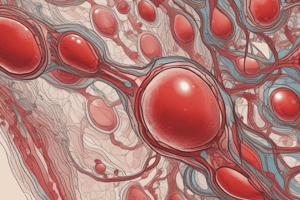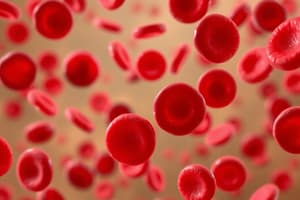Podcast
Questions and Answers
What is the primary site of action for erythropoietin?
What is the primary site of action for erythropoietin?
- Bone marrow (correct)
- Thymus
- Spleen
- Lymph nodes
What is the purpose of receptor-mediated endocytosis?
What is the purpose of receptor-mediated endocytosis?
- To release ligands into the extracellular fluid
- To secrete waste products out of the cell
- To break down proteins in the cytosol
- To internalize specific target molecules into the cell (correct)
What triggers the process of receptor-mediated endocytosis?
What triggers the process of receptor-mediated endocytosis?
- Increases in cellular metabolism
- Ligands binding to receptors on the membrane surface (correct)
- Low pH levels in the extracellular fluid
- High concentrations of ligands in the cytosol
Which type of blood cell is stimulated by erythropoietin?
Which type of blood cell is stimulated by erythropoietin?
What forms as a result of the plasma membrane invaginating and pinching off?
What forms as a result of the plasma membrane invaginating and pinching off?
What is the primary function of erythropoietin in the bone marrow?
What is the primary function of erythropoietin in the bone marrow?
Where are the receptors located that bind to ligands during receptor-mediated endocytosis?
Where are the receptors located that bind to ligands during receptor-mediated endocytosis?
Which of the following is NOT a target of erythropoietin?
Which of the following is NOT a target of erythropoietin?
What is the primary function of thymosins?
What is the primary function of thymosins?
What is the term for the molecule that binds to a receptor during receptor-mediated endocytosis?
What is the term for the molecule that binds to a receptor during receptor-mediated endocytosis?
What is the term for the process by which the plasma membrane invaginates and pinches off to form a vesicle?
What is the term for the process by which the plasma membrane invaginates and pinches off to form a vesicle?
Which type of immune cell is stimulated by thymosins?
Which type of immune cell is stimulated by thymosins?
What is the purpose of the receptors on the plasma membrane during receptor-mediated endocytosis?
What is the purpose of the receptors on the plasma membrane during receptor-mediated endocytosis?
What is the result of high concentrations of ligands in the extracellular fluid?
What is the result of high concentrations of ligands in the extracellular fluid?
What is the primary function of M-Phase promoting factor in dividing cells?
What is the primary function of M-Phase promoting factor in dividing cells?
Which hormone is responsible for stimulating growth, cell division, and differentiation in various tissues?
Which hormone is responsible for stimulating growth, cell division, and differentiation in various tissues?
What is the primary target of prolactin in the mammary glands?
What is the primary target of prolactin in the mammary glands?
What is the role of M-Phase promoting factor in the cell cycle?
What is the role of M-Phase promoting factor in the cell cycle?
Which hormone is responsible for stimulating growth and development of mammary glands and ducts?
Which hormone is responsible for stimulating growth and development of mammary glands and ducts?
What is the primary function of growth hormone in various tissues?
What is the primary function of growth hormone in various tissues?
What is the role of M-Phase promoting factor in cellular differentiation?
What is the role of M-Phase promoting factor in cellular differentiation?
Which hormone is not responsible for stimulating growth and cell division in various tissues?
Which hormone is not responsible for stimulating growth and cell division in various tissues?
During which phase of Mitosis do chromosomes become visible under a light microscope?
During which phase of Mitosis do chromosomes become visible under a light microscope?
What is the term for the protein-bound areas of the centromere that attach to spindle fibers?
What is the term for the protein-bound areas of the centromere that attach to spindle fibers?
During which phase of Mitosis do daughter chromosomes arrive at opposite ends of the cell?
During which phase of Mitosis do daughter chromosomes arrive at opposite ends of the cell?
What is the term for the process of cell division that results in two daughter cells with the same number of chromosomes as the parent cell?
What is the term for the process of cell division that results in two daughter cells with the same number of chromosomes as the parent cell?
During which phase of Mitosis do nuclear membranes reform and chromosomes uncoil?
During which phase of Mitosis do nuclear membranes reform and chromosomes uncoil?
What is the term for the division of the cytoplasm to form two distinct new cells?
What is the term for the division of the cytoplasm to form two distinct new cells?
What is the term for the rate of cell division?
What is the term for the rate of cell division?
What is the term for cells that maintain the cell populations of high mitotic rate cells?
What is the term for cells that maintain the cell populations of high mitotic rate cells?
What is the term for the process of programmed cell death?
What is the term for the process of programmed cell death?
During which phase of Mitosis do chromatids move toward the metaphase plate?
During which phase of Mitosis do chromatids move toward the metaphase plate?
What is the name of the structure formed when pseudopodia surround an object?
What is the name of the structure formed when pseudopodia surround an object?
Which process is the functional reverse of endocytosis?
Which process is the functional reverse of endocytosis?
What is the name of the extension of the cell membrane that surrounds an object during phagocytosis?
What is the name of the extension of the cell membrane that surrounds an object during phagocytosis?
What is the name of the membrane-bound compartment that contains the engulfed object?
What is the name of the membrane-bound compartment that contains the engulfed object?
What is the term for the release of vesicle contents into the extracellular environment?
What is the term for the release of vesicle contents into the extracellular environment?
What is the name of the process by which cells engulf solid objects?
What is the name of the process by which cells engulf solid objects?
What is the term for the cellular structure that sorts and modifies proteins and lipids synthesized by the endoplasmic reticulum?
What is the term for the cellular structure that sorts and modifies proteins and lipids synthesized by the endoplasmic reticulum?
What is the name of the process by which cells take in fluid and dissolved substances?
What is the name of the process by which cells take in fluid and dissolved substances?
What is the term for the fusion of a vesicle with the plasma membrane?
What is the term for the fusion of a vesicle with the plasma membrane?
What is the name of the compartment where the engulfed object is broken down?
What is the name of the compartment where the engulfed object is broken down?
Flashcards are hidden until you start studying
Study Notes
Hormones and Cell Division
- Erythropoietin targets bone marrow, stimulating stem cell division and maturation of red blood cells.
- Thymosins target the thymus and other lymphoid tissues, stimulating division and differentiation of lymphocytes.
Cell Division (Mitosis)
- Early Prophase: Chromosomes become visible under a light microscope, and an array of microtubules called spindle fibers extends between centriole pairs.
- Late Prophase: DNA replication during S phase results in a copy of every one of the 46 chromosomes, and each copy is called a chromatid connected to its duplicate at a single point called the centromere.
- Metaphase: Chromatids move toward the metaphase plate, aligning with the metaphase plate and ending when chromatids are aligned.
- Anaphase: The two daughter chromosomes are pulled apart and drawn toward opposite ends of the cell along chromosomal microtubules.
- Telophase: The nuclear membrane reforms, and the nucleus enlarges; chromosomes gradually uncoil, marking the end of mitosis.
- Cytokinesis: The division of the cytoplasm forms two distinct new cells, beginning in late anaphase and continuing throughout telophase.
Chemical Factors Affecting Cell Division
- M-Phase promoting factor: A regulator mechanism active in all dividing cells, initiating mitosis.
- Growth hormone: Targets all cells, especially in epithelial and connective tissue, stimulating growth, cell division, and differentiation.
- Prolactin: Targets gland and duct cells of mammary glands, stimulating growth, cell division, and development of mammary glands and ducts.
Endocytosis and Exocytosis
- Receptor-mediated endocytosis: Produces vesicles containing a specific target molecule (ligand) in high concentrations, which bind to receptors on the membrane surface, forming pockets that pinch off to form an endosome.
- Phagocytosis: A type of endocytosis involving the engulfment of solid objects, such as bacteria, by pseudopodia, forming a phagosome.
- Exocytosis: The functional reverse of endocytosis, used by the Golgi apparatus to transport its product outside the cell; vesicle contents are released into the extracellular environment.
Studying That Suits You
Use AI to generate personalized quizzes and flashcards to suit your learning preferences.




